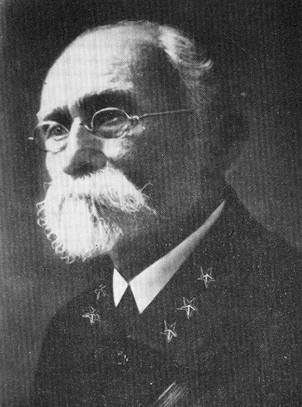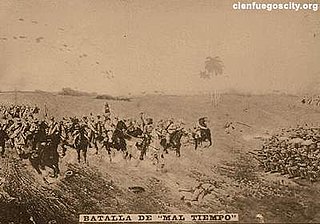
The Cuban Revolutionary Armed Forces are the military forces of Cuba. They include Revolutionary Army, Revolutionary Navy, Revolutionary Air and Air Defense Force, and other paramilitary bodies including the Territorial Troops Militia, Youth Labor Army, and the Defense and Production Brigades, plus the Civil Defense Organization and the National Reserves Institution. All these groups are subordinated to the Ministry of the Revolutionary Armed Forces.

Lt. General José Antonio de la Caridad Maceo y Grajales was a Cuban general and second-in-command of the Cuban Army of Independence.

Dulce María Loynaz Muñoz was a Cuban poet, and is considered one of the principal figures of Cuban literature. She was awarded the Miguel de Cervantes Prize in 1992. She earned her Doctorate in Civil Law at University of Havana in 1927.

Máximo Gómez y Báez was a Dominican Generalissimo in Cuba's War of Independence (1895–1898). He was known for his controversial scorched-earth policy, which entailed dynamiting passenger trains and torching the Spanish loyalists' property and sugar plantations—including many owned by Americans. He greatly increased the efficacy of the attacks by torturing and killing not only Spanish soldiers, but also Spanish sympathizers and especially Cubans loyal to Spain. By the time the Spanish–American War broke out in April 1898, the rebellion was virtually defeated in most of Western Cuba, with only a few operating pockets in the center and the east. He refused to join forces with the Spanish in fighting off the United States, and he retired to the Quinta de los Molinos, a luxury villa outside of Havana after the war's end formerly used by captains generals as summer residence.

The Cuban War of Independence, also known in Cuba as The Necessary War, fought from 1895 to 1898, was the last of three liberation wars that Cuba fought against Spain, the other two being the Ten Years' War (1868–1878) and the Little War (1879–1880). The final three months of the conflict escalated to become the Spanish–American War, with United States forces being deployed in Cuba, Puerto Rico, and the Philippine Islands against Spain. Historians disagree as to the extent that United States officials were motivated to intervene for humanitarian reasons but agree that yellow journalism exaggerated atrocities attributed to Spanish forces against Cuban civilians.

The following outline is provided as an overview of and topical guide to Cuba:

Karol Rolow-Miałowski or Carlos Roloff Mialofsky, better known simply as Carlos Roloff, was a Polish-born Cuban general and liberation activist, who fought against Spain in the Ten Years' War and the Cuban War of Independence in the Las Villas Province.

Agustín Cebreco Sánchez, was a Cuban major general and politician of the Mambí Army.

Serafín Gualberto Sánchez Valdivia was a Cuban patriot, abolitionist and a participant of all three Cuban wars of independence. Additionally he participated in the Gómez-Maceo Plan. He reached the rank of major general. He participated in more than 120 fights. He was also a surveyor and teacher. Brother of Colonel Sabás Raimundo Sánchez Valdivia and Brigadier José Joaquín Sánchez Valdivia. He maintained a solid friendship with Máximo Gómez and José Martí, who considered him a brother.

Juan Bruno Zayas Alfonso was a Cuban military leader and doctor of the Cuban War of Independence.
The Battle of Iguará was a battle of the Cuban War of Independence which took place on December 13, 1895 in the Santa Clara Province, Cuba.

The Battle of Mal Tiempo was a battle of the Cuban War of Independence that took place on December 15, 1895, a few kilometers away from Cruces, Cienfuegos Province. In the battle, Mambises and Spanish forces faced each other, the former being victorious. This victory was considered one of the most important of the Invasion from East to West in Cuba, due to the political, military and economic consequences in favor of the independence activists.
The Battle of Coliseo was a group of military actions carried out in the surroundings of the town of the same name, Matanzas Province, Cuba on December 23, 1895 during the Cuban War of Independence.

América Arias López, also known as América Arias de Gómez was a Cuban philanthropist and benefactor, known for her charitable initiatives, as well as her support for various organizations and publications in Cuba. Arias was the second First Lady of Cuba from 1909 to 1913 as the wife of President José Miguel Gómez. She was a prominent, early supporter of the Cuban independence movement and served as a messenger and nurse during the Little War with the rank of captain.

The La Reforma Campaign was a campaign of the Cuban War of Independence which was waged for 16 months with the Cuban forces under the command of Máximo Gómez against the Spanish forces under the command of Valeriano Weyler. Despite the Spanish outnumbering the Cuban forces by 40,000 to 600, Gómez's guerrilla warfare tactics as well as the weather caused over 40 Spanish soldiers to die each day throughout the campaign. His approach was to divide his forces into tiny guerrilla groups and fight alone with his General Staff while continuously moving.

Francisco Carrillo Morales (1851-1926) was a Cuban politician and general who participated in all three wars of Cuban Independence. He commanded the 4th Army Corps during the Cuban War of Independence as a Major General. He was also known as the 6th Vice President of Cuba from May 20, 1921, to May 20, 1925, as well as a governor of several Cuban provinces.

The Cuban Liberation Army, colloquially known as the Mambí Army was an insurgent army which was formed in the last third of the 19th century and fought for independence from Spain and the abolition of slavery. It first saw combat in the Ten Years' War (1868-1878) under the command of Carlos Manuel de Céspedes, Ignacio Agramonte, and Carlos Roloff. The independentists were decentralized and operated within their own regions autonomously of each other, until the Assembly of Guáimaro established the Republic-in-Arms of Cuba and the Liberation Army's command structure. After the Pact of Zanjón, a brief uprising called the Little War saw Major-Generals Calixto García and Antonio Maceo lead the Army of Liberation in another attempt at independence and the abolition of slavery, though unsuccessfully. Finally, during the War of Independence, the Liberation Army was once again organized to fight against the Spanish colonial government. The Liberation Army would reach its highest count of active members in the Spanish-American War, when an imminent Cuban-American victory caused hitherto anti-independence elites to join the Liberation Army. These recruits were nicknamed "Sunflowers" because they "point to where the sun is shining".

Enrique Loynaz del Castillo was a Dominican-born Cuban general and independence activist of the late 19th-century and early 20th-century. He was known for his service in the Cuban War of Independence, participating in the battles of Mal Tiempo and Paso de las Damas.
















